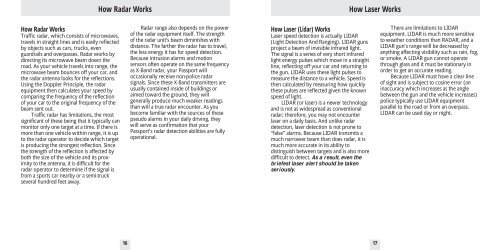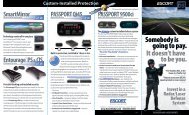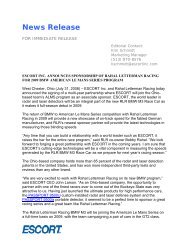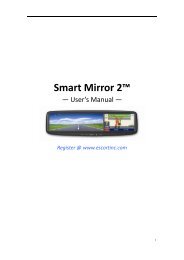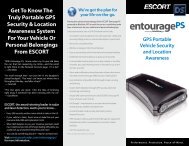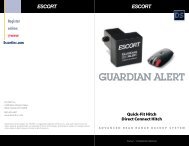Passport SR7 Remote Owner's Manual - Escort Inc.
Passport SR7 Remote Owner's Manual - Escort Inc.
Passport SR7 Remote Owner's Manual - Escort Inc.
Create successful ePaper yourself
Turn your PDF publications into a flip-book with our unique Google optimized e-Paper software.
How Radar Works<br />
Traffic radar, which consists of microwaves,<br />
travels in straight lines and is easily reflected<br />
by objects such as cars, trucks, even<br />
guardrails and overpasses. Radar works by<br />
directing its microwave beam down the<br />
road. As your vehicle travels into range, the<br />
microwave beam bounces off your car, and<br />
the radar antenna looks for the reflections.<br />
Using the Doppler Principle, the radar<br />
equipment then calculates your speed by<br />
comparing the frequency of the reflection<br />
of your car to the original frequency of the<br />
beam sent out.<br />
Traffic radar has limitations, the most<br />
significant of these being that it typically can<br />
monitor only one target at a time. If there is<br />
more than one vehicle within range, it is up<br />
to the radar operator to decide which target<br />
is producing the strongest reflection. Since<br />
the strength of the reflection is affected by<br />
both the size of the vehicle and its proximity<br />
to the antenna, it is difficult for the<br />
radar operator to determine if the signal is<br />
from a sports car nearby or a semi-truck<br />
several hundred feet away.<br />
How Radar Works How Laser Works<br />
Radar range also depends on the power<br />
of the radar equipment itself. The strength<br />
of the radar unit's beam diminishes with<br />
distance. The farther the radar has to travel,<br />
the less energy it has for speed detection.<br />
Because intrusion alarms and motion<br />
sensors often operate on the same frequency<br />
as X-Band radar, your <strong>Passport</strong> will<br />
occasionally receive non-police radar<br />
signals. Since these X-Band transmitters are<br />
usually contained inside of buildings or<br />
aimed toward the ground, they will<br />
generally produce much weaker readings<br />
than will a true radar encounter. As you<br />
become familiar with the sources of these<br />
pseudo alarms in your daily driving, they<br />
will serve as confirmation that your<br />
<strong>Passport</strong>’s radar detection abilities are fully<br />
operational.<br />
How Laser (Lidar) Works<br />
Laser speed detection is actually LIDAR<br />
(Light Detection And Ranging). LIDAR guns<br />
project a beam of invisible infrared light.<br />
The signal is a series of very short infrared<br />
light energy pulses which move in a straight<br />
line, reflecting off your car and returning to<br />
the gun. LIDAR uses these light pulses to<br />
measure the distance to a vehicle. Speed is<br />
then calculated by measuring how quickly<br />
these pulses are reflected given the known<br />
speed of light.<br />
LIDAR (or laser) is a newer technology<br />
and is not as widespread as conventional<br />
radar; therefore, you may not encounter<br />
laser on a daily basis. And unlike radar<br />
detection, laser detection is not prone to<br />
“false” alarms. Because LIDAR transmits a<br />
much narrower beam than does radar, it is<br />
much more accurate in its ability to<br />
distinguish between targets and is also more<br />
difficult to detect. As a result, even the<br />
briefest laser alert should be taken<br />
seriously.<br />
16 17<br />
There are limitations to LIDAR<br />
equipment. LIDAR is much more sensitive<br />
to weather conditions than RADAR, and a<br />
LIDAR gun’s range will be decreased by<br />
anything affecting visibility such as rain, fog,<br />
or smoke. A LIDAR gun cannot operate<br />
through glass and it must be stationary in<br />
order to get an accurate reading.<br />
Because LIDAR must have a clear line<br />
of sight and is subject to cosine error (an<br />
inaccuracy which increases as the angle<br />
between the gun and the vehicle increases)<br />
police typically use LIDAR equipment<br />
parallel to the road or from an overpass.<br />
LIDAR can be used day or night.


